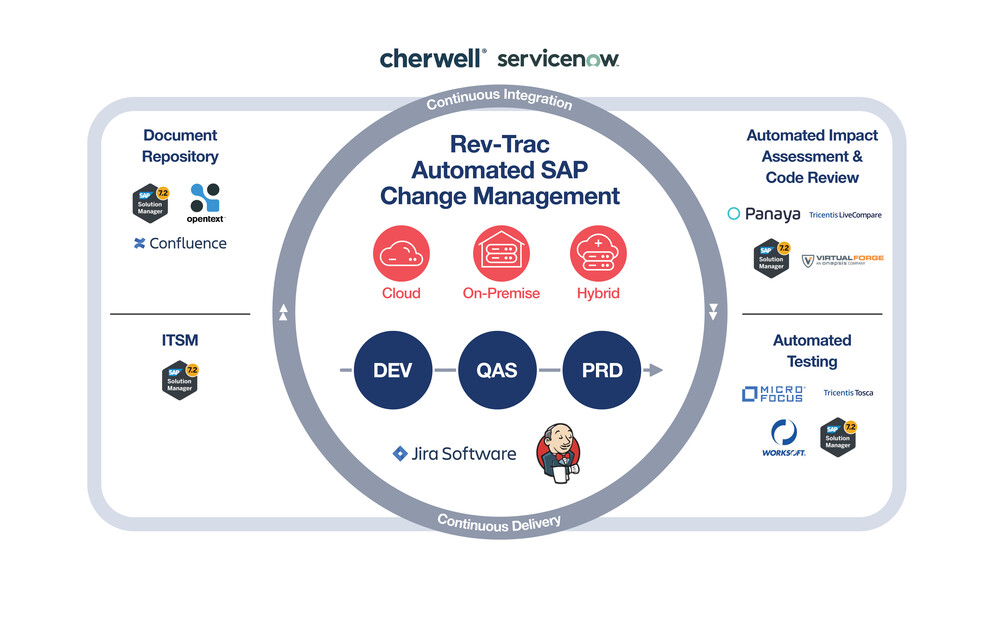No doubt automation in change and transport management is a massive game-changer. Here at Rev-Trac, it’s been our focus since the very beginning.
And, our customers have experienced the benefits and ROI associated with automating their change management processes for over 20 years.
More recently, however, integration and SAP DevOps have become top of mind for organizations wishing to:
- Respond quickly to constant changes in business demand
- Release faster and work smarter
- Massively reduce development costs
- Focus on innovation – and not ‘just keep the lights on’
Myself, I have worked in the SAP change management sector for almost 17 years.
And, it was about four to five years ago that SAP DevOps became a hot topic.
Yet, Rev-Trac has always been able to facilitate a DevOps approach to the development of SAP applications and enhancements.
Make SAP DevOps a reality
I first heard about integrating Rev-Trac with another tool more than 10 years ago.
At the time, we took steps to integrate Rev-Trac with another 3rd party tool to help the company better manage change across an SAP landscape.
Unfortunately, the integration was shelf-ware for most of the decade, mostly because it was ahead of its time.
Then DevOps infiltrated the SAP space. Suddenly, integration (and by extension automation) was a buzz word.
It became the centrepiece of discussion for anything relating to change management.
Is SAP DevOps possible?
Despite the buzz around DevOps, organizations have questioned that DevOps is even possible in an SAP environment.
Why? Too many stakeholders with separate areas of focus are a challenge that large teams often face in building a tightly integrated DevOps backend.
Test managers are focused on testing, and Dev team leads want to deliver more code faster than ever before, while Ops teams are nervous about what is migrated into the production environment.
Where do you invest in tools that essentially work on the same value stream?
Yet, despite the competing objectives, the various groups have a common goal. Each team wants its focus area to be more automated.
Automation is critical to success!
The closer you get to achieving your SAP DevOps objectives, the more automated your systems and processes need to be.
Automating your SAP tasks and integrating ALM tools into a single unified platform allows you to deliver more applications, more frequently without breaking production.
The foundation of a successful SAP DevOps toolchain – where all toolsets are integrated to allow the continuous delivery of SAP change – is integration and automation.
As a team leader, when you are selling technology and technology alone, it can be difficult.
However, when you pitch a solution, and the impact it has on the business – it’s much easier.
For organizations considering implementing an SAP DevOps strategy, an end-to-end solution is critical, and automation makes it a reality.

Automation provides the glue between the disparate toolsets, ensuring the correct technology is called and used at the proper time.
Naturally, a business is not going to use all the toolsets (shown) but would deploy the technologies that best meet their needs.
How does the integration work?
Rev-Trac leverages flexible REST APIs and Event Listeners for bi-directional integration with best-of-breed ALM and DevOps tools to eliminate time lags and minimize manual handling errors.
If your organization uses disparate and unconnected tools to perform SAP tasks, bi-directional integration can really pay off.
Consider the DevOps toolchain above – an SAP change is created in ServiceNow which triggers the creation and population of a Rev-Trac Request.
You may need to feed information back into ServiceNow at different stages in the process.
With bi-directional integration, exchanging data between tools is seamless with information being sent in either direction.
At times – depending on your workflow — different tools will perform required tasks with actions initiated via a two-way data exchange between Rev-Trac and the appropriate solution.
Why automate?
A DevOps toolchain is not a chain unless all ALM solutions are linked together in some way.
By fully automating (and integrating) SAP change tasks and activities, you can achieve your DevOps objectives, speed up delivery cycles and massively reduce operational costs.
Automation
- Removes bottlenecks;
- Eliminates costly human error; and
- Calls the correct tool at the right time.
Additionally, often different tools are purchased for other projects, and upon completion are sometimes forgotten.
If you have configured an end-to-end automated SAP DevOps toolchain, no tool is left behind or forgotten.
To discover how Rev-Trac can assist in building a unified SAP DevOps toolchain contact one of our change management experts. Or visit here for more information.


